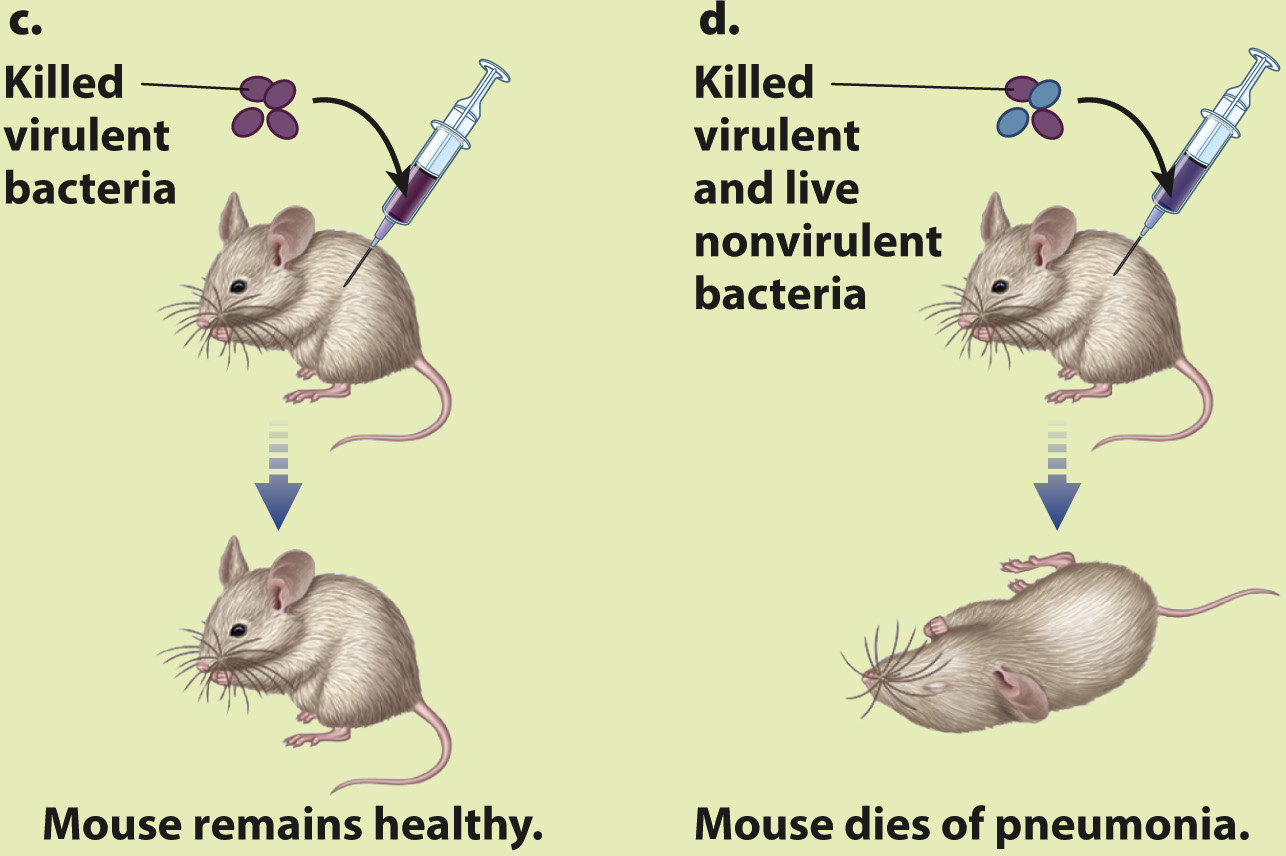DNA can transfer biological characteristics from one organism to another.
The first experiments to demonstrate that molecules can transfer genetic information from one organism to another were carried out in 1928 by Frederick Griffith, working with the bacterium Streptococcus pneumoniae. This organism causes a variety of infections in humans and a deadly form of pneumonia in mice. In the original experiments, illustrated in Fig. 3.1, Griffith studied two strains of the bacterium, one a virulent (harmful) strain that caused pneumonia and death when injected into mice, and the other a mutant, nonvirulent strain that allowed injected mice to survive. When the debris of dead virulent cells was mixed with live nonvirulent cells, some of the nonvirulent cells became virulent. Griffith concluded that some type of molecule in the debris carried the genetic information for virulence, but he did not identify the molecule.
HOW DO WE KNOW?
FIG. 3.1
What is the nature of the genetic material?
BACKGROUND In the 1920s, it was not clear what biological molecule carries genetic information. Fred Neufeld, a German microbiologist, identified several strains of the bacterium Streptococcus pneumoniae, one of which was virulent and caused death when injected into mice (Fig. 3.1a), and another which was nonvirulent and did not cause illness when injected into mice (Fig. 3.1b).

EXPERIMENT Frederick Griffith was also a microbiologist interested in bacterial virulence. He made a puzzling observation. He noted that nonvirulent bacteria do not cause mice to get sick (Fig. 3.1b) and virulent bacteria that had been killed do not cause mice to get sick (Fig. 3.1c), but when the two were mixed, the injected mice got sick and died (Fig. 3.1d). Furthermore, when he isolated bacteria from the dead mice, they had the appearance of the virulent strain, even though he had injected nonvirulent bacteria.
RESULTS

CONCLUSION One strain of bacteria (nonvirulent) can be transformed into another (virulent) by an unknown molecule from the virulent cells. In other words, the unknown molecule carries information that causes virulence.
FOLLOW-
SOURCE Griffith, F. 1928. “The Significance of Pneumococcal Types.” Journal of Hygiene 27:113–
Experiments carried out in 1944 by Oswald Avery, Colin MacLeod, and Maclyn McCarty showed that the molecule responsible for the conversion, or transformation, of nonvirulent cells into virulent cells is DNA (Fig. 3.2). These scientists killed virulent cells with heat, and then purified the remains to make a solution, or preparation. They found that the preparation could carry out transformation. When the preparation was treated with enzymes that destroy any trace of protein or RNA, the transforming ability of the preparation remained. But when the preparation was treated with an enzyme that destroys DNA, the transforming ability was lost.
These experiments, along with others, established that DNA is the genetic material. Today, transformation is widely used in biological research and in the genetic modification of agricultural plants and animals (Chapter 12).
HOW DO WE KNOW?
FIG. 3.2
What is the nature of the genetic material?
BACKGROUND Oswald Avery, Colin MacLeod, and Maclyn McCarty also studied virulence in pneumococcal bacteria. They recognized the significance of Griffith’s experiments (see Fig. 3.1) and wanted to identify the molecule responsible for transforming nonvirulent bacteria into virulent ones.
EXPERIMENT Avery, MacLeod, and McCarty prepared an extract from virulent bacteria that could transform nonvirulent bacteria into virulent ones. This extract allowed them to perform a series of tests and controlled experiments. To identify what caused transformation, they separated the extract into its macromolecular components. The transforming activity remained associated with the DNA; however, the DNA preparation also contained trace amounts of RNA and protein. They treated this preparation with enzymes that destroyed one of the three molecules. Their hypothesis was that transformation would not occur if they destroyed the molecule responsible for it.
RESULTS

CONCLUSION DNA is the molecule responsible for transforming nonvirulent bacteria into virulent bacteria. This experiment provided a key piece of evidence that DNA is the genetic material.
FOLLOW-
SOURCE Avery, O., C. MacLeod, and M. McCarty. 1944. “Studies on the Chemical Nature of the Substance Inducing Transformation of Pneumococcal Types.” Journal of Experimental Medicine 79:137–